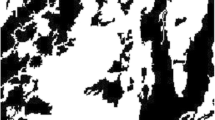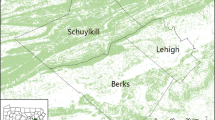Abstract
Tree row inventories are of increasing interest because tree rows mitigate wind erosion and desertification, protect agricultural crops, enhance rural landscape quality, act as bio-corridors, carbon sinks, and a source for bio-energy. The main objective of tree row inventories is to estimate population parameters such as total tree numbers, total tree numbers by species, the mean stem diameter at breast height, the mean tree height and total wood volume. The estimation of these quantities may be straightforwardly carried out whenever aerial images are available in such a way that tree rows can be counted: in these cases, a two-stage cluster sampling may be performed in which the primary units sampled in the first stage are the tree rows in the study area while the secondary units sampled in the second stage are the trees within the selected rows. This paper proposes two sets of two-stage estimators for the interest parameters, based on the Horvitz–Thompson and ratio criteria, together with the corresponding estimators for their sampling variances. The use of stratification is also considered. The proposed procedure was applied to perform a tree row inventory in the Pontina plain (Central Italy): in this case, the tree rows were enumerated by means of ortho-corrected airborne images and stratification was carried out on the basis of the prevailing species and age classes. The inventory results are interesting from a forestry perspective as well as for checking the effectiveness of the procedure.




Similar content being viewed by others
References
Bellefontaine R, Petit S, Pain-Orcet M, Deleporte P, Bertault J-G (2002) Trees outside forests. Towards better awareness. FAO Conservation Guide 35, Roma
Chevrou R (1973) Inventaire des haies. Revue Forestière Francaise 1:47–53
Cochran WG (1977) Sampling techniques. Wiley, New York
Corona P, Chiarabaglio PM, Chirici G, Coaloa D, Travaglini D (2002) Stima di alberature e frangivento tramite campionamento per intersezione lineare. L’Italia Forestale e Montana 3:276–292
David CA, Rhyner V (1999) An assessment of windbreaks in central Wisconsin. Agroforest Syst 44:313–331
De Vries PG (1986) Sampling theory for forest inventories. Springer, Berlin Heidelberg New York
Godambe VP (1955) A unified theory of sampling from finite populations. J Roy Stat Soc B 17:269–278
Hansen MH (1985) Line intersect sampling of wooded strips. Forest Science 31:282–288
Jim CY (1989) Tree-canopy characteristics and urban development in Hong Kong. Geograph Rev 79:210–225
Kleinn C (2000) On large area inventory and assessment of trees outside forests. Unasylva 200:3–10
Lapietra G, Coaloa D, Sampietro L (1985) Filari di piante da legno nella pianura lombarda. Quaderni di Ricerca SAF 5, Roma, Italy
Schreuder HT, Gregoire TG, Wood GB (1993) Sampling methods for multiresource forest inventory. Wiley, New York
Acknowledgements
The work, carried out by the authors in equal parts, was funded by ARSIAL (Latium Region). We are grateful for technical assistance from Simone Bollati and Giuseppe Clementi for their fieldwork. We would also like thanking two anonymous reviewers for their helpful comments on an earlier draft.
Author information
Authors and Affiliations
Corresponding author
Additional information
Communicated by Hans Pretzsch
Appendices
Appendix 1
The estimator (Eq. 7) may be rewritten as
i.e, as a ratio of the Horvitz–Thompson estimators of Y and X, where the numerator is a two-stage estimator while the denominator needs only of the first stage of sampling.
The expansion of Eq. 13 by means of a Taylor series up to the first order in a neighbourhood of Y and X gives rise to
where R=Y/X. Since \({\hat{X}}_{\rm HT}\) is a constant with respect to second-stage sampling, it follows that
where E 2 and V 2 denote expectation and variance with respect to the second stage, while Y i and σ2 i represent the total and the variance of the interest variable in row i.
From Eq. 14 it is at once apparent that the expectation of \({\hat{Y}}_{\rm RAP2}\) approximately equals the Taylor series approximation of the familiar one-stage ratio estimator
From the well-known properties of Eq. 15 (see e.g., Cochran 1977, chap. 6), it follows that
where \(\sigma^{2}_{e} = \frac{1}{N - 1}{\sum_{i = 1}^{N} e^{2}_{i}}, e_{i} = Y_{i} - RX_{i}\) while E 1 and V 1 denote expectation and variance with respect to the first stage.
Now, it is worth noting that an unbiased estimator of \(V({\hat{Y}}_{\rm RAP2})\) is given by
where \(s^{2}_{{\tilde{e}}} = \frac{1}{n - 1} \sum\nolimits_{i \in S} ({\tilde{e}}_{i} - {\bar{e}})^{2} = \frac{1}{n} \sum_{i \in S} {\tilde{e}}^{2}_{i} - \frac{1}{n(n - 1)} \sum\nolimits_{h \neq i \in S} {\tilde{e}}_{i} {\tilde{e}}_{h}, {\tilde{e}}_{i} = {\hat{Y}}_{i} - RX_{i}\) and \({\bar{e}}\) denotes the sample mean of the \({\tilde{e}}_{i}{\text{s}}.\) Indeed, since
and
then
Hence
from which
Since the sum of e i extended to all the population units equals 0, it follows that
in such a way that
However, the quantity (Eq. 17) cannot be computed from the sample information, since R and hence all the residuals \({\tilde{e}}_{i} = {\hat{Y}}_{i} - RX_{i}\) are unknown. Thus, as is customary in ratio estimation, the quantities \({\hat{e}}_{i} = {\hat{Y}}_{i} - {\hat{r}} x_{i}\) may be used as residuals. Since their sample mean equals 0, when used in Eq. 17 they give rise to Eq. 8.
Appendix 2
Eq. 11 constitutes a function of \({\hat{M}}_{l}\) and \({\hat{\mu}}_{l}\) for any l ∈G. Thus, since
and
then, the Taylor series expansion of \({\hat{\mu}}_{G}\) up to the first order gives rise to
Thus, from Eq. 18 it is straightforward to prove that \({\hat{\mu}}_{G}\) turns out to be approximately unbiased with variance
But, since
quantity (Eq. 19) reduces to
which may be trivially estimated by formula 12.
Rights and permissions
About this article
Cite this article
Corona, P., Fattorini, L. The assessment of tree row attributes by stratified two-stage sampling. Eur J Forest Res 125, 57–66 (2006). https://doi.org/10.1007/s10342-005-0078-2
Received:
Accepted:
Published:
Issue Date:
DOI: https://doi.org/10.1007/s10342-005-0078-2




